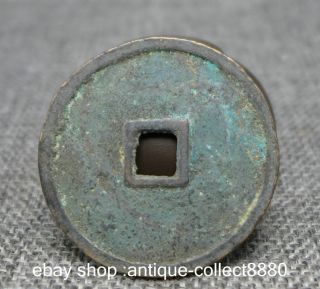

States come and go," Luo Guanzhong wrote in his novel The Three Kingdoms. And since I bet that you readers know of examples that I haven’t listed, I’m going to turn on blog comments this month – so post any countries that are missing from this list (list specific denominations and years if you can)."Kingdoms wax and wane.

#CHINESE COINS WITH HOLES UPDATE#
This is definitely not a complete list, so I will update it when I find out about other countries.

Here is a list of the countries that I’ve found that have circulated coins with holes since 1900. Fiji had holes in their half-penny and penny in the 1930s through the 1950s. Greece had holes in their 5-, 10-, and 20-lepta coins from the 1950s until the 1970s. Hungary had a hole in their 2-filler coin, used from 1950 until 1992. Spain added a hole to their 25-peseta coin in 1990 and kept it until switching to the euro in 2002. The 100-yen coin is the same size as the 5-yen, but with a reeded edge so the hole in the center helps to make the 50-yen more noticably different than the 100-yen.īesides Japan, many countries in Africa, Asia, Europe, and the Middle East have used coins with holes in the recent past, and you might be surprised by who they are. They are also nearly the same size (the 5-yen is bigger), but the 50-yen coin has a reeded edge while the 5-yen has a smooth edge. I believe that the only country currently using coins with holes is Japan, whose 5 yen and 50 yen coins both have holes in the center. Japan 5-yen (left) and 50-yen (right) coins This kind of destruction makes the coin worthless to collectors. Two holes toward the center of the coin, such as the one pictured, indicates that it may have been used as a button on a piece of clothing. A single hole near the edge means that the coin may have been worn on a necklace or bracelet. If you see a coin that has a hole near the edge, or has multiple holes (see pictures), someone has drilled a hole in the coin in order to use it for decoration or jewelry. On coins that intentionally have holes in them, the hole is always in the direct center of the coin, and usually the design of the coin incorporates the hole (so you don’t have a hole directly in the middle of a person’s head, for example). It gives the coin a unique look, like you could almost wear it as a ring. The one exception I’ve seen is the 1 pice coin from India and Pakistan in the 1940s, which had a 3/8 inch (9.5 mm) hole in a coin that was less than 1 inch (2.5 cm) across. The hole is meant to be seen and felt, but not to be worn like a ring (wouldn’t that be interesting?). Most coins that have holes in them have a relatively small hole – usually 1/4 of an inch (6.3 mm) or smaller. However, coins are usually made out of the most common and least expensive metals possible (you don’t want to make a $1 coin that uses $2 in metal) so I’m not aware of any examples of a country putting a hole in their coins for this reason.) (Putting a hole in a coin would also use less metal, which may be important when metal is needed for other uses (such as during a long war). The main reason that you would make a modern coin with a hole in it (or, for that matter, with an unusual shape), besides pure decoration, is to make it more easily distinguishable (by touch and sight) from other coins in circulation. They are not there to make the coins work in a particular machine, or to be easier to carry (although they would be slightly lighter than a coin without a hole). Plenty of other countries, however, have had one or more of this type of coin (known as “holed coins” or “holey coins”) in their recent history.Īs far as I know, the holes put into modern foreign coins don’t serve any specific purpose. The United States has never had a coin with a hole in it, so it’s not something we’re used to seeing. These coins had a square-shaped hole in the center, with Chinese characters around it. Americans, when asked about coins with holes in them, probably picture the old Chinese “cash” coins which are featured so prominently in Chinese-style decor.


 0 kommentar(er)
0 kommentar(er)
